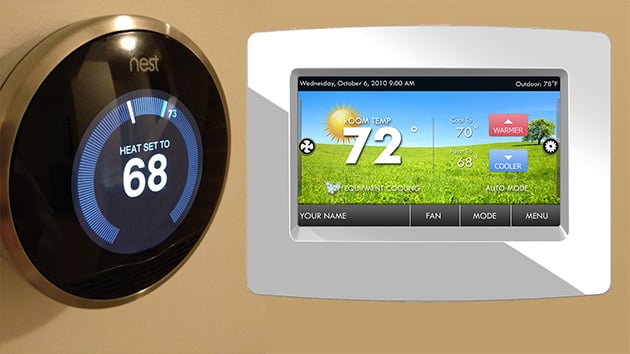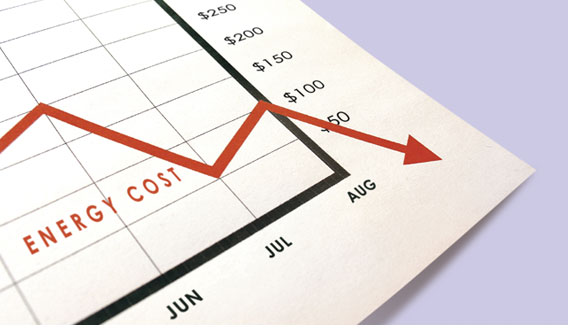
Programmable thermostats work well during the times of year when temperatures are consistently hot or cold. You can set your thermostat to the appropriate heat or cool mode and forget about it. But they aren't as effective nor convenient when fluctuating temperatures are the norm. Home owners and businesses are forced to repeatedly change the modes to adjust for each day's conditions. Recent weather across much of the country has provided an example of the unpredictable temperatures the fall and spring seasons bring. These conditions are when smart thermostats are true heroes of energy efficiency and your nerves.

Smart Thermostats Do It Better
Programmable thermostats were a major improvement over older manual thermostats, they are also one trick ponies. They do a great job of automatically changing the temperature set points of your hvac system based on a schedule. But you're still stuck making manual adjustments on days when your routine changes up. Programmable thermostats have no knowledge of holidays or snow days, let alone sick days. Try asking them to switch modes based on the current weather conditions and you might as well be talking to your toaster. Where programmable thermostats leave you wanting more, smart thermostats shine.
Smart thermostats adapt to changes in your schedule and weather conditions. They do all the work for you, freeing you up to go about your day and providing certainty that the temperature in your home or business will be managed appropriately. The energy efficiency of your hvac system will be improved too. The intelligence of the thermostats will eliminate unnecessary cycles and thus extend the life of your equipment. So let's explore what's behind these thermostats being so smart.

Adaptability to Life's Schedule, Not a Clock
There are two primary ways that intelligent thermostats acquire their knowledge about your schedule. One method used by learning thermostats such as Nest or Honeywell's Lyric. They gain their intelligence from a combination of monitoring your manual adjustments to temperature settings the first week they are installed and by detecting your motion as you move near them. Based on the collected information they automatically establish a schedule from those patterns.
The second method involves connecting a smart thermostat with an automation system in your home or business. The automation system integrates your thermostats with other systems such as security. They're also connected to the Internet to gather local weather information. This gives them access to local weather conditions in real-time. That awareness enables them to automatically switch modes based on the forecast high and low temperatures as well as current temperature and humidity reports. The collection of information provides a level of intelligence allowing the thermostats to sense when people come and go, along with the appropriate mode for your hvac system to be in.
By using information from sensors and weather data providers smart thermostats are able to take action on their own. This frees them from being slaves to a set schedule and the current mode to which they were last set.Intelligence Empowers Greater Energy Efficiency, Savings
Another benefit these intelligent thermostats provide is savings from improved energy efficiency. Their ability to adapt to schedule and weather changes, and to detect on their own when people are present enables them to more precisely manage the energy use of a hvac system. Wasted energy is all but eliminated by ensuring that the thermostats are only providing comfort level temperatures when someone is around.
Here's an everyday life example. You walk out the door and arm the security system, which relays this information the to thermostats. Knowing that no one is around, the thermostat adjusts the temperature setting to a more energy efficient level. As the temperature changes throughout the day the thermostat monitors the local weather station and makes the necessary adjustments. When you return home, the thermostat returns it's temperature set point to the comfort settings.
Maximum energy efficiency is obtained by enabling the hvac system to more precisely match the occupancy patterns in a home or commercial building. The system no longer wastes energy by providing heating and cooling when no one is there to need it. It costs 5% less in energy costs for every degree a thermostat is set back. The difference between a setting of 68 degrees and 74 degrees can be as much as 30%. Add that up over the hours when a home or commercial building is devoid of people and you're talking serious savings!

In Conclusion
Did you notice there was no reference to a schedule in the above example? That's because there weren't any. In the real world people seldom return to and leave places at the same time from day to day. We forget to set our alarms, get caught in traffic, go out with friends after work, and take the kids to their after school activities. No two days are alike which is what makes programmable thermostats so frustrating.
This year as we enter the season of giving, replace that infuriating programmable hunk of junk and give yourself the gift of a smart thermostat. Your energy bills will be lower and everyone around you will be thankful.








